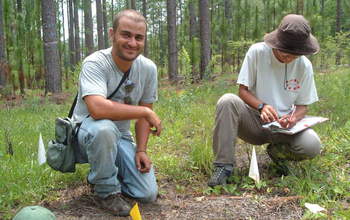Miles of linked habitat sounds like a good thing - until the ants show up.
Environmentalists who promote the notion of unintended consequences regarding genetic modification never considered that wildlife corridors might have risks also - but they do, as a recent study showed. Julian Resasco and colleagues at the University of Florida found that one type of fire ant used wildlife corridors to dominate recently created landscapes.
"Although habitat corridors are usually beneficial, they occasionally have negative effects," Resasco said."Sometimes they can help invasive species spread in exactly the same way they help native species."
Texas imported fire ant. Credit: Texas A&M University
The challenge for ecologists is to figure out when invasive species are likely to benefit from corridors. Resasco's results initially surprised the team because invasive species are usually talented in their ability to invade new areas -- they shouldn't need corridors to get around. Fire ants instead proved the even older axiom that animals follow the path of least resistance when they can.
They have two social forms: monogyne and polygyne. Monogyne fire ants fly high in the air to mate and disperse, raining down to create new colonies. Polygyne fire ants, on the other hand, mate low to the ground and sometimes crawl short distances to create new colonies. They don't spread widely and their colonies are dense.
Resasco and his team went to South Carolina to study eight sections of land, each dominated by one of the two social forms. Each section consisted of five patches of regenerating habitat. Each patch was about the size of a football field. Some were connected by a corridor and others were not, allowing the researchers to study the influence of corridors.

You don't want to see this up close on a picnic. Credit: USDA
The researchers found that corridors significantly increased the abundance of polygyne -- but not monogyne -- fire ants. In polygyne sections, native ant species' diversity was lower in patches connected by corridors than in unconnected patches. That was most likely due to the higher fire ant abundance, according to the study.
The issue is important for scientists in Florida ecause Florida has so many foreign neighbors nearby - and many of them don't arrive by legal means - invasive species are a vexing problem. The Sunshine State now worries about Cuban tree frogs, green iguanas and feral hogs. In 2013, the Florida Fish and Wildlife Conservation Commission even sponsored a Burmese python hunting challenge.
A team is even going on its second 1,000-mile expedition to raise money for the Florida Wildlife Corridor, which would be a corridor stretching from Everglades National Park to the Okefenokee National Wildlife Refuge in Georgia. But a giant corridor of conservation land could make the invasive species problem even worse.
Invasive fire ants. Crossing the border from South America to North America, they're on-the-march across the U.S. Southeast and beyond. How does habitat--in particular, corridors that connect one place with another--help these ants spread? Credit: NSF
Ultimately, Resasco said, whether corridors spread invasive species depends on dispersal ability: "It is not a coincidence that the readily dispersing monogyne form of fire ants doesn't benefit from corridors, whereas the poorly dispersing polygyne form does." For better or worse, poorly dispersing invasive species are exceptional.
More analysis is necessary to determine whether the effects of corridors on invasive species are transient or permanent. In the meantime, Resasco's paper urges land managers to consider animals' traits when making decisions about land corridors. In rare cases, their best intentions could backfire by aiding invasive species.

Scientists Julian Resasco (left) and Elizabeth Long collect data at the fire ant study site. Credit: Nick Haddad






Comments